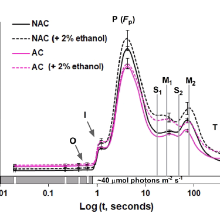Cold acclimation modifies the photosynthetic machinery and enables plants to survive at sub-zero temperatures, whereas in warm habitats, many species suffer even at non-freezing temperatures. We have measured chlorophyll a fluorescence (ChlF) and CO2 assimilation to investigate the effects of cold acclimation, and of low temperatures, on a cold-sensitive Arabidopsis thaliana accession C24. Upon excitation with low intensity (40 μmol photons m-2 s−1) ~ 620 nm light, slow (minute range) ChlF transients, at ~ 22 °C, showed two waves in the SMT phase (S, semi steady-state; M, maximum; T, terminal steady- state), whereas CO2 assimilation showed a linear increase with time. Low-temperature treatment (down to − 1.5 °C) strongly modulated the SMT phase and stimulated a peak in the CO2 assimilation induction curve. We show that the SMT phase, at ~ 22 °C, was abolished when measured under high actinic irradiance, or when 3-(3,4dichlorophenyl)-1, 1- dimethylurea (DCMU, an inhibitor of electron flow) or methyl viologen (MV, a Photosystem I (PSI) electron acceptor) was added to the system. Our data suggest that stimulation of the SMT wave, at low temperatures, has multiple reasons, which may include changes in both photochemical and biochemical reactions leading to modulations in non-photochemical quenching (NPQ) of the excited state of Chl, “state transitions,” as well as changes in the rate of cyclic electron flow through PSI. Further, we suggest that cold acclimation, in accession C24, promotes “state transition” and protects photosystems by preventing high excitation pressure during low-temperature exposure.


